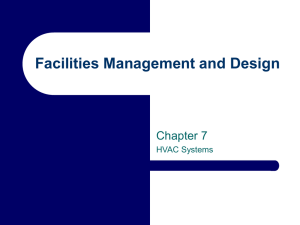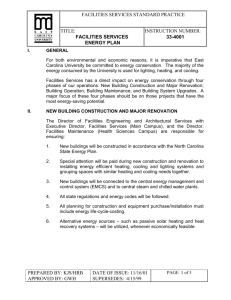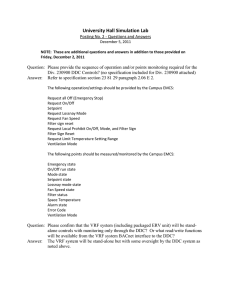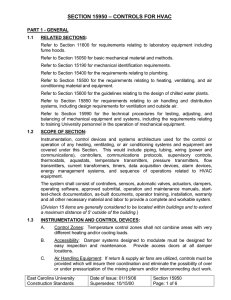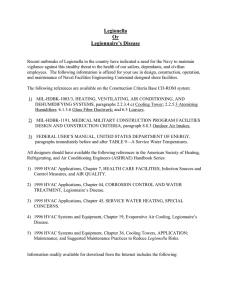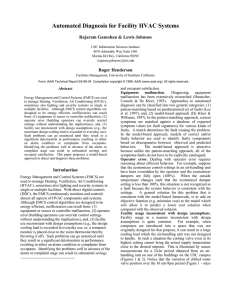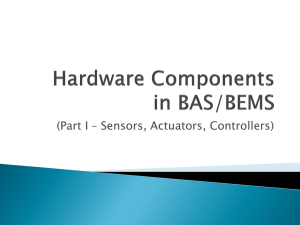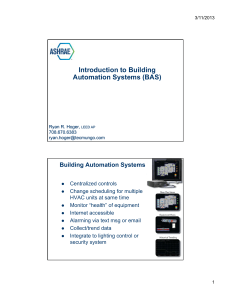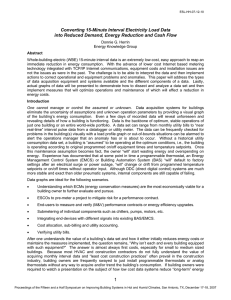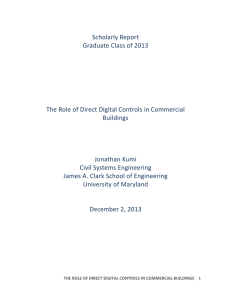Energy Management: 2010 Automation Forum OMNI OMNI Professional
advertisement
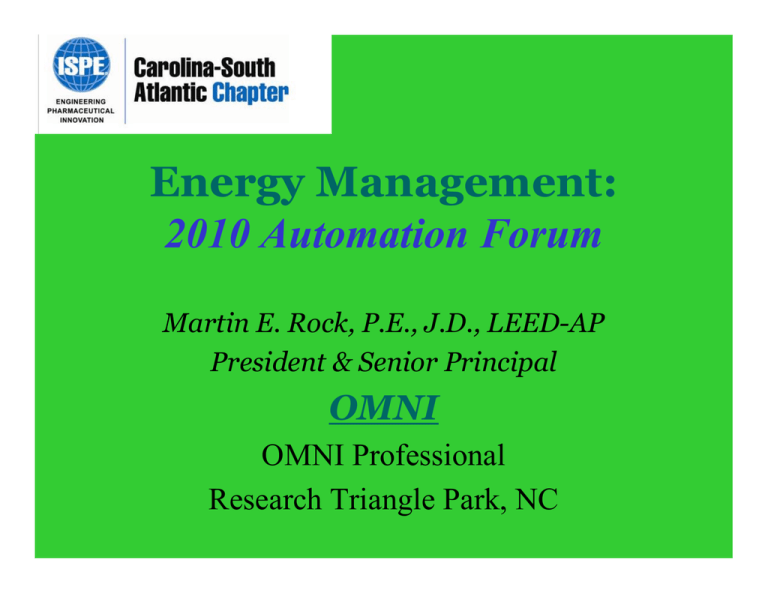
Energy Management: 2010 Automation Forum Martin E. Rock, P.E., J.D., LEED-AP President & Senior Principal OMNI OMNI Professional Research Triangle Park, NC Why are we discussing Energy Management at an Automation Forum? Pharmaceutical companies are facing a convergence of forces that will fundamentally alter traditional facility design, operations, and information management. Energy management is an important factor in strategies for meeting these challenges, including efficient facility design, predictive maintenance, improved time to market, agile (LEAN) manufacturing, and sustainability. Energy Supply & Demand Picture is an Impending Train Wreck - National Security - Economic Stability - Price Volatility -Supply Disruptions -Exploration Costs An “Oil Gap” is Expected within the next 5 to 10 years. Options - Hoarding & stockpiling of petroleum (The U.S. already does this to some extent). - Diversification of energy supply sources (renewable, biomass, nuclear, etc.) – Demand restraints (i.e., lowering standards of living) - Sustainable development (dramatic changes in current practices), and Î Energy efficiency. Is Energy Efficiency a “Free Lunch”? When asked by the FBI why he robbed banks, Willie Sutton simply replied, "Because that's where the money is." Two Major Areas of Focus Demand Buildings ‐ HVAC ‐ Lighting ‐ Equipment Process Requirements Other Generation Boilers Chillers Cogen Compressed Air Other 10 Major Systems to Consider at Pharma Plants • Building Envelope • HVAC System – people comfort (data centers are a specialized area) • Electrical Supply System • Lighting • Boiler & Steam Systems (including steam traps) 10 Major Systems to Consider (cont.) • Hot Water System - domestic • Compressed Air System • Motors – probably can’t see • Special Process Equipment • (Formulation, Blending, Milling, Granulation, Drying, Final Blending,Tabletting, Tablet Press Tooling, Coating, and Encapsulation, etc.) • Water & Sewer System Pop Quiz - Which Pump should you buy? (lowest first cost?) God is in the details . . . Anonymous Control Hierarchy • Manual – Switches & Dimmers • Open Loop Automatic – Timers – PLCs • Closed Loop Automatic – Thermostat – Humidistat – Dimmable Ballast & Photosensor (Studies show 40-60% savings from daylight harvesting.) Basic Feedback Control System Note: Even a $10 thermostat is a feedback control system. Basic Types & Basic I/O • Two-Position – On or Off, Open or Closed • Proportional – Variation from set point produces a proportional action • Digital – 1 or 0, but can be incremental. • Analog – range of positions or values Inputs & Outputs INPUTS: • Temp – • Flow – AI AI/DI • Status/Proof AI/DI • Rel. Humid AI • Pressure – AI • Air Quality AI OUTPUTS: • Motors DO (Pumps, Fans, & Process) • Lights DO • VSD AO/DO • Valves AO • Dampers AO • Light Contactors DO Evolution of EMCS • 1st Generation: (Pneumatic) Simply turn on/off devices based on need and ease of remote operation. (little concern for energy usage control.) • 2nd Generation: (PLCs) Simple electronic control boards to convert electric signals to pneumatic actions. (allowed for proportional control & basic strategy.) • 3rd Generation: (DDC) Electronic actuators replace pneumatic devices, software developments & improved control. (Human Machine Interface (HMI) very key.) Î Modern Trends: Systems are more modular with “building blocks” architecture & greater standardization. Primary Objective of EMCS • To optimize the control and sequencing of mechanical systems, thereby reducing energy consumption. • Peak Demand Limiting • Ambient Condition Lighting • Start/Stop Optimization • Sitewide Chilled Water Reset & HW Reset • Time-of-Day Scheduling • Outdoor Air Free Cooling/Humidity Controls DDC EMCS Control Strategies • Manage the Demand or Need for Energy at any given time. • Manage the Length of Time that devices consume energy. • Set Alarms when devices fail or malfunction. • Facilitate Monitoring of systems performance & present on dashboards or reports. • Assist the Operator to administer equipment maintenance. Energy Management Systems Good Maintenance Good Energy monitoring data can Gives good Energy Efficiency Predict Maintenance Needs Reliability of Operations Don’t Overlook Low-Tech Savings Opportunities Watch Outs • Indoor Air Quality – Energy Conservation measures and new control routines can create or aggravate IAQ issues. • Building Pressurization – HVAC conversions and control methods may impact building pressurization. • Vibration & Noise due to VFDs – Ex. VFD retrofit of existing cooling towers. Need to “walk-up” the fan speeds to observe where vibration occurs & program the VFD to skip those speeds. •Heat – Cool Overlap – DDC should determine whether mechanical heating or cooling systems can be turned off. (Even overlap of “free cooling” with boiler heating operation is heat-cool overlap. Overall Justification for EMCS • • • • • • • • Manage Energy Consumption & Demand Predictive Maintenance Improve Comfort Improve IAQ Activate Alarms – Fewer Disruptions Assist Operators to Administer O&M Monitor/Log Energy Use & Equip Performance Others: “Green” Image, GHG reduced, LEED Summary Don’t necessarily expect your Energy Director to be a cheerleader for sophisticated Automation . . . 1/ The basic idea is to save energy with the simplest and most reliable technology without adversely affecting comfort or operations. 2/ Don’t underestimate the “human element” in interacting with the systems you design. 3/ Watch out for simultaneous heating/cooling in HVAC Systems – a silly waste of energy but sometimes hard to control.
